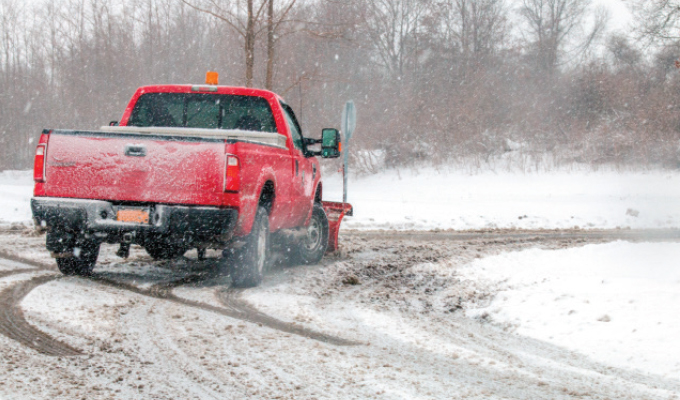By Fred Fakkema
Most regions of the country are more than familiar and prepared for severe weather conditions at some point throughout the winter months. However, even if a region can predict its winter storm season or is caught by surprise, like much of Texas earlier this year, it is imperative for fleets to practice general preparedness for operating and maintaining work trucks during subzero weather.
A combination of performing pre-and post-trip inspections, conducting regular maintenance checks on equipment, and following safety precautions will help fleet managers keep equipment up and running, drivers safe on the roads, and worksites operating in compliance with OSHA winter weather standards at worksites.
WINTER MAINTENANCE
Maintaining equipment in subzero weather conditions is half the battle, and it begins with validating the operating status of equipment. Ensuring that equipment is up to date, serviced regularly, and functioning properly is easily achieved through electronic verified inspection reporting (EVIR). For example, cables and wires are prone to freezing in subzero weather. During the pre-trip inspections, it is important to take the time to manually remove snow buildup and unthaw frozen wires or cables before operating the vehicle. Another important component of work trucks that are impacted by subzero weather conditions are fluid levels, which require regular checks and monitoring. Consider these three winter maintenance best practices:
- Overcome maintenance yard inaccessibility with over-the-air updates. Some fleets turn to technology to maintain equipment in subzero weather when vehicles stored in maintenance yards are inaccessible. Over-the-air updates through connected software to the Engine Control Module (ECM) assures vehicle engines are updated even when weather limits access to manual maintenance.
- Employ automated advisories for hours of service (HOS). Automated advisories are another technology tool that keep fleets operating in subzero weather. Advisories can help drivers plan routes ahead of time to avoid storms or allot extra time for trips through inclement weather. Automated advisory tools equip drivers with additional resources such as access to view area traffic cameras or quick reference for the 5-1-1 transportation and traffic information telephone hotline.
- Weatherproof hardware. Just as extreme heat can cause mobile hardware and tablets to malfunction, technology can also go down in cold weather. Installing designated charging stations to keep devices powered and maintained at operating temperatures ensures a fleet’s on-board technology doesn’t interfere with operations in subzero weather.
SAFETY MINDSET
As I mentioned, maintenance is half the battle, but it is also imperative for fleets to employ a winter safety mindset. When you think about the challenges of cold weather, the first thing that comes to mind is visibility and determining the exact conditions of the road. Here’s what to look for on the road to assess conditions:
- Paying attention to other vehicles on the road. Be aware of and monitor the tires of the other vehiCles on the road. In subzero conditions, if there is no debris flying off the tires of other vehicles, it indicates the road might be slick, possibly with black ice. This clue tells a driver they should travel at slower speeds. Conversely, if debris is flying off of tires, the road is wet and still has traction.
- Shift into neutral instead of slamming the breaks. In the event of an emergency stop in icy conditions, instead of slamming the breaks, which will cause the torque of the vehicle to carry forward, drivers should put the vehicle in neutral to decrease traveling speed.
COMPLIANCE & SAFETY
In the enforcement world, the seemingly obvious challenges can lead to violations for fleets. Visibility is one important aspect that enforcement looks at to see if windshields are clear of debris such as snow, ice, and mud, which can blow off in transit and damage other vehicles on the road. A few states have laws that require snow to be removed from the top of the vehicle, including trailers, to prevent danger on the road.
Functioning tires, mud flaps, lights, and windshield wipers are other maintenance flaws that law enforcement pays close attention to during the winter season. Consistent and thorough pre-and post-trip inspections are the best tool for fleets to maintain accessory equipment in subzero weather.
Another important aspect of winter maintenance is outfitting your workforce with adequate gear that adheres to OSHA standards for worksite safety. PPE, including a safety and first aid kit, gear, and the right-fitting shoes and gloves will help workers perform better in the field and avoid accidents.
Preparedness for driving on roads during extreme winter weather conditions can never be understated. Many states across the country have mandatory requirements for tire chains, especially when traveling through mountain passes. In winter, when weather conditions can turn quickly, it is imperative fleets are equipped with appropriate winter equipment and safety mindset for operating in subzero weather.
ABOUT THE AUTHOR
Fred Fakkema is the vice president of safety and compliance at Zonar. Find out more, visit
www.zonarsystems.com.




